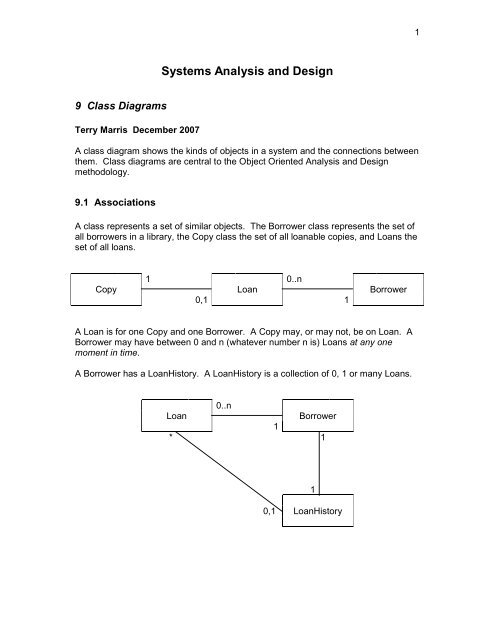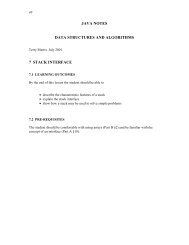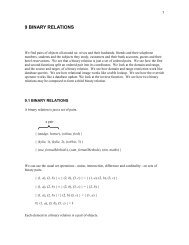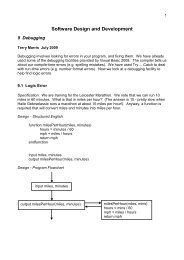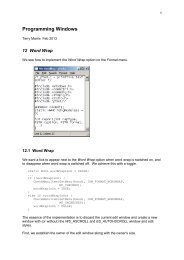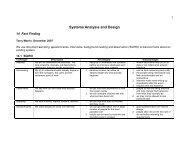Class Diagrams - tmarris.com
Class Diagrams - tmarris.com
Class Diagrams - tmarris.com
You also want an ePaper? Increase the reach of your titles
YUMPU automatically turns print PDFs into web optimized ePapers that Google loves.
1<br />
Systems Analysis and Design<br />
9 <strong>Class</strong> <strong>Diagrams</strong><br />
Terry Marris December 2007<br />
A class diagram shows the kinds of objects in a system and the connections between<br />
them. <strong>Class</strong> diagrams are central to the Object Oriented Analysis and Design<br />
methodology.<br />
9.1 Associations<br />
A class represents a set of similar objects. The Borrower class represents the set of<br />
all borrowers in a library, the Copy class the set of all loanable copies, and Loans the<br />
set of all loans.<br />
1 0..n<br />
Copy Loan Borrower<br />
0,1 1<br />
A Loan is for one Copy and one Borrower. A Copy may, or may not, be on Loan. A<br />
Borrower may have between 0 and n (whatever number n is) Loans at any one<br />
moment in time.<br />
A Borrower has a LoanHistory. A LoanHistory is a collection of 0, 1 or many Loans.<br />
0..n<br />
Loan<br />
Borrower<br />
1<br />
* 1<br />
1<br />
0,1 LoanHistory
2<br />
Lecturer and Student are both kinds of Borrower, each with their own set of<br />
borrowing rules. For example. a Student can borrow up to four books for up to three<br />
weeks. A Lecturer can borrow up to six books for up to six weeks.<br />
Borrower<br />
Lecturer<br />
Student<br />
9.2 Attributes<br />
An object has a set of attributes. Attributes? What are the attributes of your ideal<br />
partner? Attributes are derived from what an object has. For example, a student has<br />
a course and a loanLimit.<br />
Student<br />
course<br />
loanLimit<br />
A Borrower has a name and an idNumber. A Lecturer has a name, an idNumber and<br />
a faculty and loanLimit. A Student has a name, an idNumber and a course and<br />
loanLimit.<br />
Borrower<br />
name<br />
idNumber<br />
Lecturer<br />
faculty<br />
loanLimit<br />
Student<br />
course<br />
loanLimit
3<br />
9.3 Operations<br />
An object knows all about itself. It can tell you what its attributes are. And it can<br />
change some of them for you. A Borrower can tell you what its LoanHistory is and<br />
can add new loans to its LoanHistory.<br />
Borrower<br />
name<br />
idNumber<br />
getLoanHistory<br />
addLoan<br />
An operation accesses attributes. Attributes are usually private and not accessible<br />
except via operations. An operation can get attributes for you and can update their<br />
values.<br />
9.4 <strong>Class</strong> Diagram<br />
Borrower<br />
name<br />
idNumber<br />
getLoanHistory<br />
addLoan<br />
class name<br />
attributes<br />
operations<br />
In the early stages of analysis, class diagrams are simply named boxes together with<br />
their associations. As analysis progresses, attributes and operations are added - not<br />
necessarily all of them, just the important ones.<br />
Notice the structure of a class diagram. The box is divided into three <strong>com</strong>partments.<br />
The class name is shown emboldened. Important attributes are shown in the middle<br />
section. The bottom section is for the operations.<br />
Bibliography<br />
FOWLER M UML Distilled 2nd Ed Addison-Wesley 2000<br />
http://www.agilemodeling.<strong>com</strong>/artifacts/classDiagram.htm accessed 20 Dec 2007


